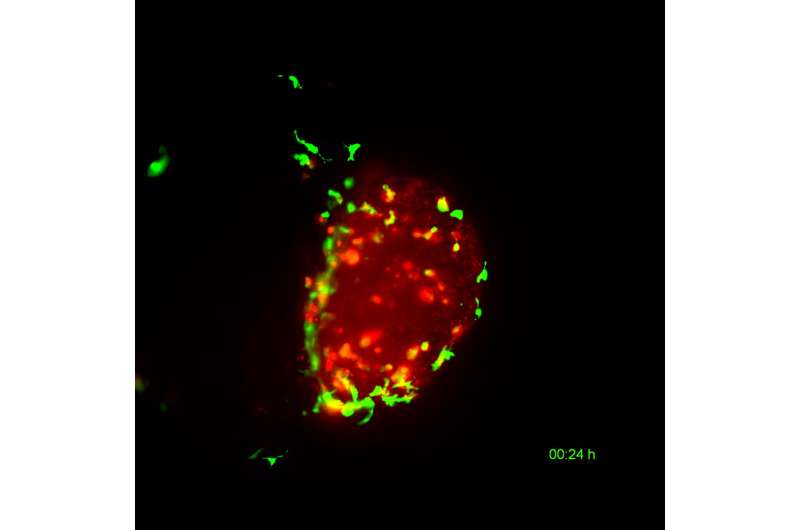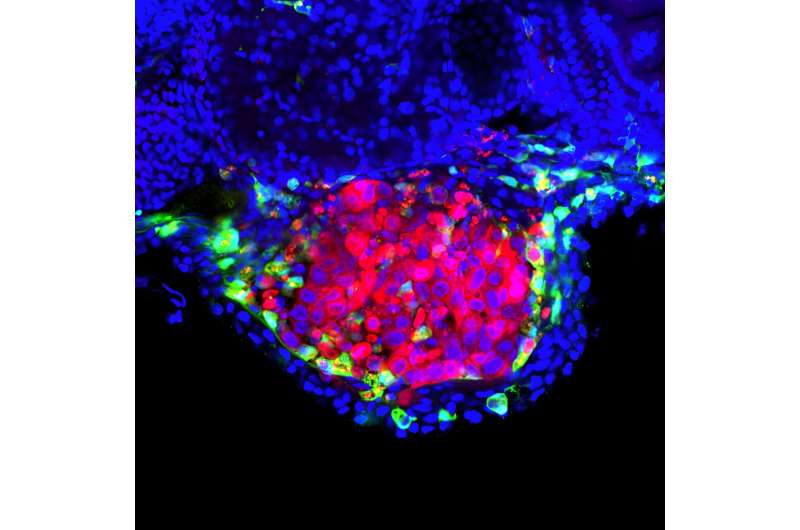This article has been reviewed according to Science X's editorial process and policies. Editors have highlighted the following attributes while ensuring the content's credibility:
fact-checked
peer-reviewed publication
proofread
Scientists unravel how the BCG vaccine leads to the destruction of bladder cancer cells

Using zebrafish "avatars," an animal model developed by the Cancer Development and Innate Immune Evasion lab at the Champalimaud Foundation (CF), led by Rita Fior, Mayra Martínez-López—a former Ph.D. student at the lab now working at the Universidad de las Américas in Quito, Ecuador—and colleagues studied the initial steps of the Bacillus Calmette-Guérin (BCG) vaccine's action on bladder cancer cells.
Their results, which are published in the journal Disease Models and Mechanisms, show that macrophages—the first line of immune cells activated after an infection—literally induce the cancer cells to commit suicide and then rapidly eat away the dead cancer cells.
The idea behind zebrafish avatars (zAvatars), which are still an experimental but very promising model, is fairly straightforward: take tumor cells from a cancer patient and inject them into zebrafish embryos. The tumors will then grow inside the embryos, effectively turning them into avatars of that specific cancer patient. The various treatment options available for that patient can then be tested on the zAvatars. In a matter of days--rather than several weeks, or even months--that it takes using the traditional testing in mice, it will be possible to determine the best treatment for that patient. The test has been developed and studied with samples from colorectal cancer patient samples.
Fior had a new idea for applying the model. "When I joined Rita's lab, as a Ph.D. student," (in 2019), Martínez-López recalls, "we were discussing several projects I could undertake, and Rita mentioned that the BCG vaccine was being used in bladder cancer patients." Martínez-López remembered getting the BCG against tuberculosis when she was a child in South America, and had later worked on the disease. "But it was the first time I heard of the TB vaccine as a cancer treatment," she points out. And this immediately caught her attention.

The (hi)story of an idea
The BCG vaccine was first used against TB in the 1920's and then started to be used as the first cancer immunotherapy around 1976. But decades before that, in the 1890's, William Coley, a surgeon working at the New York Hospital (now Weill Cornell Medical Center) had already tested a mix of different bacteria, coined "Coley's toxins," as a cancer immunotherapy.
Coley had noticed that several virtually hopeless cancer patients at the hospital went into seemingly "miraculous" remissions from their cancer when they caught a bacterial infection following the surgery performed to remove their tumors (sterile conditions for surgical procedures were then less than optimal). His idea was that such recoveries, far from being miraculous, were in fact caused by an immune response of the patients to the infection.
Coley started trying to induce bacterial infections in a number of sarcoma patients and was able to reproduce a few cancer remissions. At the time, though, his method was far from being proven and safe—and meanwhile, other treatment methods were developed, such as radiotherapy—so his research was not pursued. But in recent years, the field of immunotherapy has gained enormous momentum, bringing new and more scientifically robust ways of boosting the immune system to fight cancer.
"BCG immunotherapy is still rather empirically used," says Martínez-López. "However, since it works for many people, it has become a gold standard treatment. Surprisingly, it is a very effective immunotherapy, even when compared to so many fancy immunotherapies that are being developed."
The treatment consists of instilling the BCG vaccine directly into the bladder. When the treatment works, the 15-year survival rate for patients with so-called "non-muscle-invasive" (early-stage) bladder cancer is 60% to 70%. However, in 30% to 50% of the cases, bladder tumors are unresponsive to BCG treatment. In these cases, the whole bladder has to be removed.
The macrophages have it
Until now, the way the BCG vaccine works as an immunomodulator to clear bladder tumors was not fully known.
The team's idea was that immune cells, and in particular macrophages resident in the bladder, were involved. They were able to determine what happens right after BCG is injected into zebrafish avatars. To do this, they used so-called light sheet microscopy and confocal imaging, which allowed them to see the macrophages interacting with the tumor cells, at single cell resolution and in real time.
The colorful movies they obtained of the process triggered by the vaccine (in which the macrophages and cancer cells were labeled with different fluorescent dyes) showed that macrophages are heavily recruited to the tumor site upon BCG injection, directly killing human bladder cancer cells via a process of cell suicide (apoptosis) dependent on a substance called tumor necrosis factor (TNF) secreted by macrophages, that acts as a potent signal molecule of the immune system.
They further showed that when macrophages were depleted in the zAvatar, the anti-tumor effects of the BCG vaccine were completely blocked, thus demonstrating that macrophages are indeed crucial for the initial anti-tumor response.
"What Mayra saw," says Rita Fior, "was that if you inject BCG, you have a marked increase of the amount of macrophages going into the tumor." In the presence of BCG, the immune cells changed color from red to yellow, which meant they expressed TNF.
"Not only did we unravel the mechanisms involved in the first steps of the vaccine's anti-tumoural action, we also demonstrated that the zebrafish avatar model is a powerful preclinical tool for drug discovery in oncology," concludes Martínez-López.
More information: Macrophages directly kill bladder cancer cells through TNF signaling in an early response to BCG therapy, Disease Models & Mechanisms (2024). DOI: 10.1242/dmm.050693



















